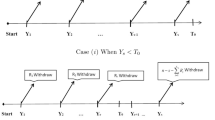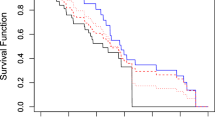Abstract
A system with n independent components which works if and only if a least k of its n components work is called a k-out-of-n system. For exponentially distributed component lifetimes, we obtain point and interval estimators for the scale parameter of the component lifetime distribution of a k-out-of-n system when the system failure time is observed only. In particular, we prove that the maximum likelihood estimator (MLE) of the scale parameter based on progressively Type-II censored system lifetimes is unique. Further, we propose a fixed-point iteration procedure to compute the MLE for k-out-of-n systems data. In addition, we illustrate that the Newton–Raphson method does not converge for any initial value. Finally, exact confidence intervals for the scale parameter are constructed based on progressively Type-II censored system lifetimes.


Similar content being viewed by others
References
Arikawa S, Furukawa K (1999) In: Discovery science: second international conference, DS’99. Springer, Tokyo
Balakrishnan N (2007) Progressive censoring methodology: an appraisal. Test 16:211–296 (with Discussions)
Balakrishnan N, Aggarwala R (2000) Progressive censoring: theory, methods and applications. Birkhäuser, Boston
Balakrishnan N, Cramer E (2014) The art of progressive censoring. Applications to reliability and quality. Birkhäuser, New York
Balakrishnan N, Cramer E, Kamps U, Schenk N (2001) Progressive type II censored order statistics from exponential distributions. Statistics 35:537–556
Balakrishnan N, Kateri M (2008) On the maximum likelihood estimation of parameters of Weibull distribution based on complete and censored data. Stat Probabil Lett 78:2971–2975
Cohen AC (1963) Progressively censored samples in life testing. Technometrics 5:327–339
Cramer E, Kamps U (1996) Sequential order statistics and \(k\)-out-of-\(n\) systems with sequentially adjusted failure rates. Ann Inst Stat Math 48:535–549
Glen AG (2010) Accurate estimation with one order statistic. Comput Stat Data Anal 54:1434–1441
Harter HL (1961) Estimating the parameters of negative exponential populations from one or two order statistics. Ann Math Stat 32:1078–1090
Hermanns M, Cramer E (2017) Likelihood inference for the component lifetime distribution based on progressively censored parallel systems data. J Stat Comput Simul 87:607–630
Kulldorff G (1963) Estimation of one or two parameters of the exponential distribution on the basis of suitably chosen order statistics. Ann Math Stat 34:1419–1431
Lagarias JC, Reeds JA, Wright MH, Wright PE (1998) Convergence properties of the Nelder–Mead simplex method in low dimensions. SIAM J Optim 9:112–147
Papageorgiou NS, Kyritsi-Yiallourou ST (2009) Handbook of applied analysis. Springer, New York
Pham H (2010) On the estimation of reliability of \(k\)-out-of-\(n\) systems. Int J Syst Assur Eng Manag 1:32–35
Potdar KG, Shirke DT (2014) Inference for the scale parameter of lifetime distribution of \(k\)-unit parallel system based on progressively censored data. J Stat Comput Simul 84:171–185
Pradhan B (2007) Point and interval estimation for the lifetime distribution of a \(k\)-unit parallel system based on progressively type-ii censored data. Econ Qual Control 22:175–186
Pradhan B, Kundu D (2009) On progressively censored generalized exponential distribution. Test 18:497–515
Wu SJ (2002) Estimations of the parameters of the Weibull distribution with progressively censored data. J Jpn Stat Soc 32:155–163
Wu SJ, Kus C (2009) On estimation based on progressive first-failure-censored sampling. Comput Stat Data Anal 53:3659–3670
Acknowledgements
The authors are grateful to two anonymous reviewers and an associate editor for their comments and suggestions which led to an improved version of the manuscript.
Author information
Authors and Affiliations
Corresponding author
Appendix
Appendix
Proof
(Theorem 1) We consider the limits of \(\frac{\partial l_{\mathbf {Y}}}{\partial \lambda }({\mathbf {y}};\lambda )\) for \(\lambda \rightarrow 0\) and \(\lambda \rightarrow \infty \),
As a consequence the function \(\frac{\partial l_{\mathbf {Y}}}{\partial \lambda }({\mathbf {y}};\lambda )\) has to be zero for some \(\widehat{\lambda }>0\) since it is a continuous function. Thus, \(\widehat{\lambda }\) is a solution of the likelihood equation. The first derivative \(\frac{\partial l_{\mathbf {Y}}}{\partial \lambda }({\mathbf {y}};\lambda )\) is strictly decreasing since \(\frac{\partial ^2l_{\mathbf {Y}}}{\partial \lambda ^2}({\mathbf {y}};\lambda )<0\) for \(\lambda >0\), see (8). Therefore, \(\widehat{\lambda }\) is the unique solution of the equation \(\frac{\partial l_{\mathbf {Y}}}{\partial \lambda }({\mathbf {y}};\lambda )=0\), \(\lambda >0\). Then, \(\widehat{\lambda }\) is the global maximum of \(l_{\mathbf {Y}}\) and the MLE of \(\lambda \) since \(l_{\mathbf {Y}}\) is a strictly concave function on \((0, \infty )\). \(\square \)
Proof
(Lemma 1) First, we rewrite \(\phi (x)\) for \(x\in (0,\infty )\):
Let \(x\in (0,1]\). Then, a lower bound results from the inequalities
where we used the inequality \(e^x-1\ge x\), \(x\in [0,\infty )\), in \((*)\). For \(x\in [1,\infty )\) and \(j\in \mathbb {N}_0\), we obtain
In the last inequality, we used that \(\frac{xe^x}{(e^x-1)^2}\) is strictly decreasing on \([1,\infty )\). As a direct consequence, we find
Hence, the function \(\phi \) is bounded and continuous on \((0,\infty )\). Then, the function \(\phi \) has a global minimum \(\phi _{\mathrm{min}}\) on the interval \((0, \infty )\). Obviously, \(\phi (x)\le 0\), \(x\in (0, \infty )\). The limits for \(x\rightarrow 0+\) and \(x\rightarrow \infty \) are easily obtained by standard calculations.
Proof
(Theorem 2) The proof uses the Banach fixed-point theorem (cf. Papageorgiou and Kyritsi-Yiallourou 2009, p. 226) for the continuous continuation of \(\xi \) on \([0, \infty )\). For the definition of the continuous continuation of \(\xi \) on \([0,\infty )\), we need the following limit
where we have used l’Hôspital’s rule to get \(\lim _{\lambda \rightarrow 0}\frac{\lambda }{1-e^{-y_i\lambda }}=\lim _{\lambda \rightarrow 0}\frac{1}{y_ie^{-y_i\lambda }}=\frac{1}{y_i}\) for \(i=1,\ldots ,v\). Then, the limit of \(\xi \) for \(\lambda \rightarrow 0\) is given by
Therefore, the continuous continuation of \(\xi \) on \([0,\infty )\) is defined as follows
Since \(\widetilde{\xi }(0)>0\) we conclude that \(\lambda =0\) can not be a fixed-point of \(\widetilde{\xi }\) on \([0,\infty )\). Hence, a fixed-point of \(\widetilde{\xi }\) must be a fixed-point of \(\xi \), too. Notice that we need the continuous continuation of \(\widetilde{\xi }\) on \([0, \infty )\) for formal reasons in order to get a complete metric space. Now, according to the Banach fixed-point theorem, we have to show
-
(I) \(\widetilde{\xi }[0,\infty )\subseteq [0,\infty )\) and
-
(II) \(\widetilde{\xi }\) is Lipschitz continuous with Lipschitz constant \(K\in [0,1)\).
Due to \(\widetilde{\xi }(0)>0\), it is sufficient to show \(\xi (0,\infty )\subseteq (0,\infty )\) to ensure \(\widetilde{\xi }[0,\infty )\subseteq [0,\infty )\). According to Eq. (8), the first derivative of the log-likelihood function \(\frac{\partial l_{\mathbf {Y}}}{\partial \lambda }({\mathbf {y}};\lambda )\) is strictly decreasing and the limit for \(\lambda \rightarrow \infty \) is given by \(-k\sum _{i=1}^v(R_i+1)y_i\). Then, \(\frac{\partial l_{\mathbf {Y}}}{\partial \lambda }({\mathbf {y}};\lambda )>-k\sum _{i=1}^v(R_i+1)y_i\) for \(\lambda \in (0,\infty )\). It follows \(\xi (\lambda )>0\) for \(\lambda \in (0,\infty )\) since \(a\ge \frac{n+k}{2k}>1\). Therefore, condition (I) is satisfied.
The functions \(\xi \) and \(\widetilde{\xi }\) are differentiable on \((0,\infty )\) and have the same derivative. To ensure condition (II), it is sufficient to show that the derivative is bounded in the interval \([-K, K]\) with \(K=\sup _\lambda |\frac{d}{\mathrm{d}\lambda }\xi (\lambda )|\in [0, 1)\) (see Arikawa and Furukawa 1999, p. 176). We define
Then, we get
Using \(x>1-e^{-x}\) and \(e^x>x+1\) for \(x>0\), we have
Substituting \(x=\lambda y_i>0\), we get
where \(\overline{y}=\frac{1}{v}\sum _{i=1}^vy_i\). Applying Lemma 1, this yields
Using
we get
Thus, we know \(\frac{d}{\mathrm{d}\lambda }\xi (\lambda )\in (-1,1)\) for \(\lambda \in (0,\infty )\). To ensure \(\sup _\lambda |\frac{d}{\mathrm{d}\lambda }\xi (\lambda )|\in [0,1)\), it is sufficient to show that \(\lim _{\lambda \rightarrow 0}\frac{d}{\mathrm{d}\lambda }\xi (\lambda ),\lim _{\lambda \rightarrow \infty }\frac{d}{\mathrm{d}\lambda }\xi (\lambda )\in (-1,1)\). Using \(\lim _{\lambda \rightarrow 0}G_\lambda (y_i)=0\), \(\lim _{\lambda \rightarrow \infty }G_\lambda (y_i)=\infty \) for \(i=1,\ldots ,v\) and l’Hôspital’s rule in \((*)\), we get
Then, we arrive at
where we used the limits of \(\phi \). Then, the limits of \(\frac{d}{\mathrm{d}\lambda }\xi \) are given by
The inequality \((**)\) is only strict for censored data, i.e., \((R_1,\ldots ,R_v)\ne (0,\ldots ,0)\). For the non-censored case, we have \(a=\max \left( \frac{n+k}{2k},\frac{n}{k}\right) =\frac{n}{k}\), because \(k<n\). Then, we get \(\lim _{\lambda \rightarrow 0}\frac{d}{\mathrm{d}\lambda }\xi (\lambda )=-\frac{1}{a}\cdot \frac{n+k}{2k}>-1\). Hence, we have \(\lim _{\lambda \rightarrow 0}\frac{d}{\mathrm{d}\lambda }\xi (\lambda ),\lim _{\lambda \rightarrow \infty }\frac{d}{\mathrm{d}\lambda }\xi (\lambda )\in (-1,0)\). Therefore, condition (II) is satisfied. Using Banach’s fixed-point theorem, we know that a fixed-point \(\widehat{\lambda }\) of \(\widetilde{\xi }\) exists, which is a fixed-point of \(\xi \), too. Then, \(\frac{\partial l_{\mathbf {Y}}}{\partial \lambda }({\mathbf {y}};\widehat{\lambda })=0\) and \(\widehat{\lambda }\) is the MLE of \(\lambda \). Furthermore, the Banach fixed-point theorem yields that the sequence \(\lambda _{h+1}=\widetilde{\xi }(\lambda _h)=\xi (\lambda _h)\) converges to \(\widehat{\lambda }\) for every \(\lambda _0\in (0,\infty )\). \(\square \)
Proof
(Lemma 2) For \(i=1,\ldots ,v\), the inner part of the logarithm in (13) can be rewritten as
According to (6), the derivative of H w.r.t. \(\lambda \) is given by
and thus negative. Hence, the inner part of the logarithm is strictly decreasing in \(\lambda \) so that \(\eta (\lambda )\) strictly increases in \(\lambda \). The limits of \(\eta (\lambda )\) for \(\lambda \rightarrow 0\) and \(\lambda \rightarrow \infty \) are
Hence, the function \(\eta :(0,\infty )\rightarrow (0,\infty )\) is strictly increasing and continuous so that the equation \(\eta (\lambda )=t\) has an unique solution for \(t>0\). \(\square \)
Proof
(Theorem 3) From Lemma 2, the solutions \(\eta \left[ {\mathbf {Y}},\chi _{2v}^2(\alpha /2)\right] \) and \(\eta \left[ {\mathbf {Y}},\chi _{2v}^2(1-\alpha /2)\right] \) exist. Using \(\eta \sim \chi _{2v}^2\), we have
Notice that, according to Lemma 2, \(\eta \) is strictly increasing in \(\lambda \) so that the direction of the inequalities does not change. \(\square \)
Rights and permissions
About this article
Cite this article
Hermanns, M., Cramer, E. Inference with progressively censored k-out-of-n system lifetime data. TEST 27, 787–810 (2018). https://doi.org/10.1007/s11749-017-0569-8
Received:
Accepted:
Published:
Issue Date:
DOI: https://doi.org/10.1007/s11749-017-0569-8
Keywords
- Progressive Type-II censoring
- k-out-of-n system
- MLE
- Fixed-point iteration
- Exact confidence intervals
- Exponential distribution




